In recent years, finding the right people to paint lines on local roads has sometimes been a source of discombobulation for the City of Sault Ste. Marie.
Some road-striping outfits work faster than others. But they don't always do it right, fouling traffic and leaving drivers confused and exasperated when they put lines where they don't belong.
For years, the job in Sault Ste. Marie was done by 2228977 Ontario Inc., which did business as R&N Maintenance or Rann Maintenance of Guelph, Ont.
R&N Maintenance, which sometimes was the only bidder, sometimes raised eyebrows and indignations with its line placements.
"I personally have found that the company... which has been doing our line-painting for the past couple of years, is very quick at painting lines, but I find there were an awful lot of mistakes," said now-Mayor Matthew Shoemaker in 2019, when he was a Ward 3 councillor.
"I see there was only one response to the request for tenders, so there's not much option for voting against this," Shoemaker said at the time.
"I'm not terribly pleased that they're the only respondent. I'm sure that there will be mistakes no matter who is responded to, but I do wish that other options were available."
One example was R&N's creative redesign in 2015 of the intersection of Albert and East streets.
Local pundit Doug Millroy wrote numerous critical columns about the new configuration there, which he called a "screw-up" and Shoemaker referred to as "crazy."
The city hired a traffic engineering consultant to study the re-striped intersection but R&N's version was retained.
In 2018, the company was fined $70,000 after a member of one of its road-maintenance crews was critically injured in Toronto when a kettle of asphalt sealant spilled.
The worker had been instructed to ride with the kettle in the back of a truck. The truck stopped suddenly and 165°C molten asphalt overflowed the functioning kettle, severely burning him.
This year, the city received five bids from companies wanting to stripe our streets.
Only one tender was from northern Ontario: from North-West Lines Ltd. of Thunder Bay.
This week, city council awarded a three-year contract to low bidder McGuinness Coatings Ltd., based in Port Perry, a town just up Hwy. 12 from Oshawa, Ont.
McGuinness has an option to extend that contract for an additional two years, subject to city approval.
R&N also bid on the contract, but was second-lowest after McGuinness, which is estimated to receive $226,197 during the contract's first year.
"The standard service period for the work is between June 1 and July 15 of each year, and to be scheduled accordingly with the recommended vendor who has indicated that onsite work will be completed within five days," said Karen Marlow, the city's manager of purchasing.
The following description of road striping, including important tips for preventing serious damage to your vehicle, is from the city's website:
Line painting
Standards for pavement markings in Ontario are defined in the Ontario Traffic Manual.
The line painting of roadways in Sault Ste. Marie is maintained by a contractor hired by the City of Sault Ste. Marie.
Yellow center line, white lane and edge-line markings are painted once a year: usually mid-June once the street sweeping program is completed.
Several years ago, the city's line-painting operation converted to water-based paints with low Volatile Organic Compounds (VOC) in an effort to decrease the impact to the environment.
Newly constructed and resurfaced roads are marked as soon as possible after paving is complete, although there may be delays due to weather or ongoing construction activities. Care should be taken in unmarked areas.
Intersection markings (stop bars, crosswalks and arrows) are applied using paint and thermoplastic. The thermoplastic is far more durable than paint and can better stand up to the extreme wear these markings are subject to. Thermoplastic markings have a lifespan of five to 10 years. The painted markings have to be reapplied annually.
The municipality has approximately 211 kilometres of yellow centre line, 117 kilometers of white lane lines and 180 kilometres of white edge lines painted on an annual basis.
Our line painting contractor normally works with 2-3 line painting trucks plus buffer vehicles to perform this work. The complete paint program is completed within a 48-hour period. On an average hot, dry day in the summer, dry time for road paint is approximately three to four minutes; however, this number increases with factors such as temperature and humidity.
When approaching a line-painting operation, it is recommended that vehicles wait until the line-painting truck finishes painting the section of road on which it is travelling.
The sections are intentionally kept short for the purpose of allowing motorists the opportunity to pass at the next major cross street.
Paint trucks must operate at low speeds of 10 to 20 kilometres per hour in order to paint the lines effectively. Stay behind the buffer vehicle, be patient, and seek an alternate route, if possible.
Drivers who pass either the buffer vehicle or line-painting truck, risk damage to their vehicles and the new road markings.
A common sight on freshly painted roads is "tracking" caused by impatient motorists passing the paint truck. Driving on fresh paint can compromise the quality of the reflective paint on the roadway, which can make it less visible.
Driving on fresh paint can also cause extensive damage to your vehicle. Because road paint contains glass beads to increase its reflective properties, it is not easily removed from the vehicle. If your vehicle is marked by line paint, it is recommended that you use a pressure washer on the affected areas immediately.
Note: The Public Works and Transportation Department does not remove paint from vehicles.
